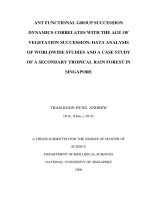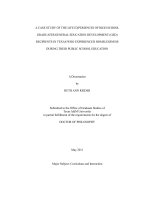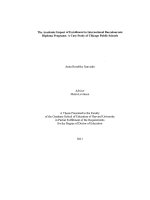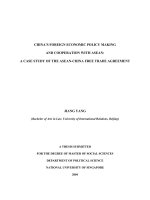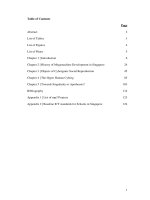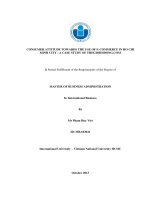A case study of the life experiences of high school graduates, general education development recipients in texas who experienced homelessness during their public school education
Bạn đang xem bản rút gọn của tài liệu. Xem và tải ngay bản đầy đủ của tài liệu tại đây (5.02 MB, 247 trang )
A CASE STUDY OF THE LIFE EXPERIENCES OF HIGH SCHOOL
GRADUATES/GENERAL EDUCATION DEVELOPMENT (GED)
RECIPIENTS IN TEXAS WHO EXPERIENCED HOMELESSNESS
DURING THEIR PUBLIC SCHOOL EDUCATION
A Dissertation
by
RUTH ANN REIDER
Submitted to the Office of Graduate Studies of
Texas A&M University
in partial fulfillment of the requirements for the degree of
DOCTOR OF PHILOSOPHY
May 2011
Major Subject: Curriculum and Instruction
UMI Number: 3471235
All rights reserved
INFORMATION TO ALL USERS
The quality of this reproduction is dependent upon the quality of the copy submitted.
In the unlikely event that the author did not send a complete manuscript
and there are missing pages, these will be noted. Also, if material had to be removed,
a note will indicate the deletion.
UMI 3471235
Copyright 2011 by ProQuest LLC.
All rights reserved. This edition of the work is protected against
unauthorized copying under Title 17, United States Code.
ProQuest LLC
789 East Eisenhower Parkway
P.O. Box 1346
Ann Arbor, MI 48106-1346
A CASE STUDY OF THE LIFE EXPERIENCES OF HIGH SCHOOL
GRADUATES/GENERAL EDUCATION DEVELOPMENT (GED)
RECIPIENTS IN TEXAS WHO EXPERIENCED HOMELESSNESS
DURING THEIR PUBLIC SCHOOL EDUCATION
A Dissertation
by
RUTH ANN REIDER
Submitted to the Office of Graduate Studies of
Texas A&M University
in partial fulfillment of the requirements for the degree of
DOCTOR OF PHILOSOPHY
Approved by:
Chair of Committee, Patricia J. Larke
Committee Members, Norvella Carter
G. Patrick Slattery
M. Carolyn Clark
Head of Department, Dennie Smith
May 2011
Major Subject: Curriculum and Instruction
iii
ABSTRACT
A Case Study of the Life Experiences of High School Graduates/General Education
Development (GED) Recipients in Texas Who Experienced Homelessness During Their
Public School Education. (May 2011)
Ruth Ann Reider, B. A., Sam Houston State University;
M.Ed., Stephen F. Austin University
Chair of Advisory Committee: Dr. Patricia Larke
The National Law Center on Homelessness and Poverty (NLCHP, 2007) recently
reported that there were 1.3 million homeless children living in the United States. The
voices of homeless children and youth are often silent, as the literature generally reflects
their experiences only indirectly, as related by care givers or social service providers. In
contrast, this study provides firsthand accounts of the difficulties encountered by
children and youth who struggle to complete their educations while being homeless.
This qualitative case study examines the personal and educational experiences of seven
adults who had been homeless as children or youth and who graduated from high school
or earned their General Education Development (GED) equivalents.
Two research questions framing this study were:
1.
What do the voices of adults who received a high school diploma or GED
tell us about their life experiences as a homeless student?
2.
What do the voices of adults who received a high school diploma or GED
tell us about their educational experiences as a homeless student?
iv
Purposeful sampling was used to locate participants. The population of this study
was culturally diverse and included African American and European American
individuals currently between the ages of 18 and 51 years. Data was generated via
interviews using a protocol designed by the author. This instrument included both fixed
and open-ended questions designed to allow participants the opportunity to share their
educational and personal experiences. Various forms of documents were also consulted.
The constant comparative method was used to analyze the data. Three categories
regarding the life experiences of homeless children and youth emerged from the study;
family, the road to homelessness and homelessness. Two categories were identified
pertaining to educational experiences; determination or self-motivation and sources of
support. The participants' testimonies confirmed some of the existing literature
regarding homeless children and youth and, in particular, supported research conducted
on the attributes of resiliency. In addition, participant narratives provided insight into
the struggles of a marginalized segment of the school population by allowing us to hear
their stories in their own words.
v
DEDICATION
I dedicate this dissertation to my parents, John and Betty Ennis, for their
encouragement, love and support throughout my life. Their commitment to education,
intervention on behalf of those who struggled and their faith in God defined much of
what they believed and who they were. They are dearly loved and missed. I picture
them playing along heavenly beaches and splashing in heavenly surf as they did during
their youths along the beaches of the Texas Gulf Coast. Family afternoons spent at the
beach are some of my fondest memories. I love you both.
I also dedicate this dissertation to my maternal grandparents, Thomas and Jane
Johnson, for their unconditional love and support throughout my life. They were the
most incredible grandparents a child could ever imagine. Nothing was impossible, as far
as they were concerned, if it was beneficial to their children and grandchildren. I have
so many wonderful memories of them both throughout my life. Thank you!
In addition, I dedicate this dissertation to my paternal grandmother, Fannie Mae
Ennis, whom I never had the opportunity to meet. I appreciate her commitment to
raising her children when she became a single mother, and her belief in the importance
of faith in God and in education.
vi
ACKNOWLEDGEMENTS
I am thankful to God for His grace and for all the blessings He has given me in
my life. I am grateful to the seven participants in this study who shared their
experiences with me in the hope that others might benefit from their life stories. I
learned more about the research topic due to the help of the participants, and was
encouraged by their testimonies.
Dr. Patricia Larke, chairperson of my dissertation committee, has been a source
of encouragement and assistance throughout my journey at Texas A&M University. She
has challenged me to “rise to the occasion” throughout my coursework and the
development of my dissertation. I have transferred that challenge to my personal life as
well. Dr. Larke welcomed me into her home for meetings and even made sure I called
her when I arrived home so that she could be sure that I had arrived safely from my
commute to College Station. She has been an unprecedented role model in my life.
When I think of Dr. Larke, I am reminded of her faith, confidence, and thoughtfulness.
Dr. Larke remained steadfast, reminding me that I could complete this study and the
Ph.D. program, even when my faith in my own abilities or my
confidence wavered. Thank you Dr. Larke!
Dr. Norvella Carter has encouraged me throughout my journey at Texas A&M
University. I met Dr. Carter at a meeting regarding the PhD program at Texas A&M
University. I felt fortunate to have been a student of Dr. Carter‟s on many occasions.
Dr. Carter is deeply committed to education and concerned about her students. Her
vii
thoughtfulness, wisdom, and cheerful demeanor are evident as she speaks. Her help
throughout this journey has been invaluable.
I first met Dr. Carolyn Clark as a student on campus at Texas A&M University.
Her insights into qualitative research and her instructional style were captivating. She
offered suggestions and support in her classes that I truly appreciate. Dr. Clark has
encouraged me during the development of my dissertation and I very much appreciate
her guidance.
I met Dr. Patrick Slattery as a student while attending classes on campus at Texas
A&M University. His uplifting personality, concern for humanity and commitment to
education were apparent even during the first day of class. Dr. Slattery‟s vital
personality, humor and insightful styles of teaching made class time appear to fly by. I
thank him for his help and enthusiasm throughout the research process.
I would especially like to thank my brother Britt, his wife Sally, their children
Britt II, Brandi, John, and Brian for their support. My brother has been a comfort to me
throughout this journey, and encouraged me to complete the writing of my dissertation
even when I felt overwhelmed. I appreciate my nephew Britt IIs' patience and
understanding.
I would especially like to thank Carolyn Donnell and the Donnell family for their
aid and hospitality. When my life was all but shattered, Carolyn was a true friend. She
encouraged me, and was confident in my abilities to overcome difficult times. Carolyn
gave me a place to live where I could collect my thoughts and begin putting my life back
together. She gave me a place to heal, and urged me to write. She patiently allowed my
viii
books and journal articles to clutter her computer room, and has driven to College
Station, Texas with me to submit copies of my manuscript to Dr. Larke. Her friendship
has been so very dear to me. I would like to thank Mrs. Jessie Hall, Carolyn‟s mother,
for encouragement and thoughtfulness. Each Saturday and Sunday I was honored to be
her dinner guest. She went to great lengths to prepare delicious family meals, making
biscuits or cornbread from scratch and preparing fresh vegetables to accent her main dish
of smothered steak, chicken and dumplings, barbeque or chicken noodle soup. She
prepared these incredible home cooked meals for Carolyn and me so that I could devote
most of my weekends to writing. Mrs. Hall and Carolyn have driven to the library at
Texas A&M University with me, boosted my spirits and given me advice commensurate
with that which I believe my parents and grandparents would have given. I truly believe
I would not have been able to complete this journey without their help and kindness.
I would like to thank Laura, Kevin, Sarah Ruth and Rebekah Carr for their
friendship and thoughtfulness. Laura, I will never forget those years at Sam Houston
State University or the wonderful memories I have of visiting you, Kevin and the girls. I
would also like to thank Ron & Kay Hohes for their confidence in my abilities to
complete this process and for their continued support. I appreciate you being such dear
friends.
I especially would like to thank my high school English teacher and class
sponsor, Mrs. Ann Plummer for encouraging me to follow my dreams. Mrs. Plummer
introduced journal writing to me and challenged me to do my best in every endeavor. As
a class sponsor, Mrs. Plummer stayed after school for class activities. Mrs. Plummer
ix
was a woman of God whose faith was unshakable and apparent in every aspect of her
life. I would also like to thank Mr. William Plummer and the whole Plummer family for
being an inspiration to me. May God bless you all.
While researching this subject and writing the dissertation, I found myself
reflecting about my own high school experiences. I would like to thank my high school
principal, M. B. Donaldson, for his direction and guidance.
I would also like to thank Dr. Archie Blanson for his endeavors in forming the
Aldine-TAMU Cohort. I would especially like to thank him for his love and
appreciation of my mother and her commitment to helping her students.
I appreciate the guidance and wisdom of Hilary Standish who encouraged me
throughout the final portion of this journey. I would like to thank Hilary for her
support.
I would like to take this opportunity to thank Joshua Hicks for his expertise and
talent regarding technology. His efforts contributed immensely to the completion of this
study.
I also thank Janet Willis, my fellow cohort member, for her friendship and
support.
x
TABLE OF CONTENTS
Page
ABSTRACT ..................................................................................................
iii
DEDICATION ...............................................................................................
v
ACKNOWLEDGEMENTS ..........................................................................
vi
TABLE OF CONTENTS ..............................................................................
x
LIST OF FIGURES .......................................................................................
xiv
LIST OF TABLES .........................................................................................
xv
CHAPTER
I
II
INTRODUCTION .................................................................
1
Statement of the Problem ...............................................
Theoretical Base .............................................................
Significance of the Study ...............................................
Purpose of the Study ......................................................
Research Questions ........................................................
A Personal Note .............................................................
Dad ....................................................................
An Educator's Perspective .................................
Me ......................................................................
Definition of Key Terms ...............................................
Assumptions and Limitations ........................................
Organization of the Study .............................................
3
3
5
6
7
7
8
14
15
19
21
22
LITERATURE REVIEW ......................................................
23
Defining Homelessness ..................................................
Policies and Legislation .................................................
The 1980s: The New Face of Homelessness …
Stewart B. McKinney Act …………………….
Bruce Vento …………………………………..
Homeless Policies in the United States:
Twenty- First Century ……………………….. .
Causes of Homelessness ………………………
23
25
25
27
27
28
30
xi
CHAPTER
III
IV
Page
Issues in Homelessness ..................................................
Four Categories of Homelessness......................
Blaming the Victim…………………………….
Why Do They Run? Runaway Youth…………
Lesbian, Gay, Bisexual, Transgender and
Questioning (LGBTQ) Homeless Youth ...........
Teenage Pregnancy and Homelessness ..............
Post-Katrina New Orleans .................................
Human Trafficking ............................................
Street Life .......................................................................
A Democratic Society: An Alternative to
Shelter Life ........................................................
The Feminization of Homelessness- Homeless
Women ...............................................................
Children and Homelessness ...............................
Caring and Effective Teachers ...........................
Educating Homeless Children and Youth ..........
Education and Homeless Adults ........................
Resilience .......................................................................
Protective Factors and Protective Mechanisms .
Spirituality .........................................................
Summary ........................................................................
31
31
31
34
RESEARCH METHODOLOGY ..........................................
75
Design of the Study ........................................................
Identification of Participants ..........................................
The Snowball Sampling Technique ...............................
Purposeful Sampling ......................................................
Challenges in Identifying Participants ...........................
Research Population .......................................................
Data.................................................................................
Documents .........................................................
Interview Procedures .........................................
The Constant Comparative Method ...............................
Summary of Research ....................................................
75
79
81
89
90
91
92
92
93
96
97
THE PARTICIPANTS: GETTING TO KNOW YOU..........
99
Participant One: Faith Architect…………………………
Participant Two: Modest Gentleman .............................
35
39
41
45
46
46
48
49
51
53
57
57
65
72
74
102
109
xii
CHAPTER
Page
Participant Three: Optimistic Survivor .........................
Participant Four: Prosperous Matriarch ........................
Participant Five: Rebel Bride ...............................................
Participant Six: Sensitive Citizen ..................................
Participant Seven: Scholarly Model ..............................
V
VI
MIRROR IMAGE: WHAT DO THE VOICES OF ADULTS
WHO EARNED A HIGH SCHOOL DIPLOMA OR GED
TELL US ABOUT THEIR LIVES AS HOMELESS
YOUTHS? ...........................................................................
113
116
119
121
124
127
Family ...........................................................................
The Influence of the Mother ..............................
The Influence of the Father Figure ....................
The Road to Homelessness ............................................
Shane's Four Categories of Homelessness ........
Shattered Dreams: Sexual Abuse ......................
Homelessness .................................................................
Living Temporarily with Friends or Family ......
Living on the Streets ..........................................
School Experiences While Homeless.............................
High School Graduation ....................................
GEDs .................................................................
Summary ........................................................................
129
129
132
134
134
138
143
143
143
145
150
151
151
EDUCATIONAL EXPERIENCES .......................................
153
Self-Motivation and Determination ...............................
The Promise .......................................................
Self-Motivation..................................................
Determination ....................................................
GED Recipients..............................................................
No One Else Can Do This for Me .....................
I Need to Do This for Myself ............................
Court Ordered ....................................................
I Have to Depend on Myself..............................
Support Systems .............................................................
Family ................................................................
Friends ...............................................................
Teachers .............................................................
Residential Shelters ...........................................
153
154
158
159
160
161
162
164
167
171
172
173
174
177
xiii
CHAPTER
Page
Spirituality and Faith .............................................................
178
SUMMARY, DISCUSSION, AND RECOMMENDATIONS
181
Summary ........................................................................
Discussion ......................................................................
Question One: Life Experiences as a Homeless
Student………………………………………..
Question Two: Educational Experiences ..........
Perceptions of Homelessness .........................................
The Road to Homelessness ................................
Homelessness ....................................................
Determination and Support ............................................
Determination.................................................................
Support ..............................................................
Resilience Theory...........................................................
Bernard's Protective Factors ..............................
Recommendations ..........................................................
182
183
REFERENCES……………… ......................................................................
212
APPENDIX A ……………………….. ........................................................
223
APPENDIX B ……………. ..........................................................................
225
APPENDIX C …………….. .........................................................................
228
VITA....................................................................................... .......................
231
VII
183
186
188
189
192
196
197
197
201
208
209
xiv
LIST OF FIGURES
FIGURE
Page
3.1
The Snowball Sampling Technique, Participants 1-2 ............
83
3.2
The Snowball Sampling Technique, Participants 3-5 ............
85
3.3
The Snowball Sampling Technique, Participants 6-7 ............
89
5.1
Participant Experiences .........................................................
128
5.2
Participant Experiences: Family ...........................................
134
5.3
Participant Experiences: The Road to Homelessness ...........
145
5.4
Participant Experiences: Homelessness ...............................
150
6.1
Educational Experiences: Achieving their Goal ...................
154
6.2
Educational Experiences: Determination or Self-Motivation
171
6.3
Educational Experiences: Support ........................................
180
xv
LIST OF TABLES
TABLE
4.1
Page
Participants' Demographic Information and
Educational Status .................................................................
102
Participants' Periods of Homelessness and
Educational Achievements ....................................................
126
5.1
Participants' Categories of Homelessness .............................
135
5.2
Causes of Homelessness Among Participants .......................
138
5.3
Causes of Homelessness: Female Participants .....................
141
4.2
1
CHAPTER I
INTRODUCTION
Imagine what it would be like to play „hide and seek‟ and be left
unfound. You get lost and can‟t find your way home. You are left to wander,
to make your own way, in a strange and hostile world with no one caring.
This bleak scenario is lived by many children and youth in America today.
They are the homeless children who are in the United States (Shane, 1996, p.
3).
Children and youth in the United States of America are experiencing
homelessness at an alarming rate. Multiple social indicators suggest that the destitution
of homelessness for American families, children and youth typically impacts individuals
and then radiates outward in a ripple effect, subsequently touching public schools, health
care facilities and social service providers prior to the phenomenon receiving attention at
a national level. In 2007, the National Law Center on Homelessness and Poverty
(NLCHP) reported that 1.3 million children were homeless in the United States. Images
of homelessness in America are often that of the single male, but in reality many
homeless are families, children, and youth. During the 1980s the emergence of homeless
_____________
This dissertation follows the style of the American Educational Research Journal.
2
families increased at a rate not recorded in the United States since the Great Depression
of the 1930s.
Barbara Duffield (2001) cited the emergence of homeless families as the new
face of homelessness. Although, homelessness is recurrent in the history of the United
States, the degree to which it is currently experienced by families and children is
particularly disturbing. Families, women, and children reflect this new face of
homelessness (Duffield, 2001; NLCHP, 2007). As families struggle to survive and
remain together, children have become the proportion of the homeless population that
has increased most dramatically. As a result, both children and youth experience
interruptions during their education, which in turn results in a high dropout rate.
Shane (1996) has divided child and youth homelessness into four categories;
familial, unaccompanied, street youth, and babies. Families often struggle to remain
together while homeless. Children accompanied by an adult family member while
homeless represent the familial homeless population. Homeless children who have been
removed from the custody of their parents or who voluntarily leave home are defined as
unaccompanied. Children or youth who are unaccompanied and literally reside on the
streets are considered street youth. Shane (1996) identified homeless babies as infants
who are born to homeless women, or who are have been abandoned.
Bonnie Bernard‟s studies regarding resilience have led her to recognize four
characteristics of resilience, namely “social competence, problem solving, autonomy,
and a sense of purpose and future” (Bernard, 1993, p. 44). Bernard further emphasizes
3
protective factors enabling the resilient child or youth to surpass their circumstances or
challenges (Bernard, 2004).
Although literature exists regarding child and youth homelessness, and research
regarding resilience has evolved, there has been minimal concern with uniting the two
subjects. Children and youth who do not merely survive, but rise above the challenges
of homelessness and graduate from high school or receive their General Education
Development (GED) equivalent have rarely been the subject of investigation. They are
truly resilient children and unique among the homeless population. Their ability to
succeed despite obstacles warrants attention.
Statement of the Problem
Homelessness among children and youth is increasing at an alarming rate.
However, minimal studies have been devoted to this issue. Even fewer investigations
have examined resilient homeless children and youth. The literature regarding homeless
children and youth has been represented primarily from the perspective of secondary
sources such as mothers living in shelters, medical professionals, and social service
providers (Bassuk, Rubin, & Lauriat, 1986). The voices of homeless students have not
been adequately considered in discussions of the problem or when enacting legislation.
Theoretical Base
The ability of the human species to excel while experiencing life threatening or
invasive circumstances remains the primary focus of resilience. Norman Garmezy,
4
revered as the founder of the study of resilience has defined resilience as “manifest
competence despite exposure to significant stressors (Rolf & Glantz, 1999, p. 7).
Garmezy‟s identification of resilience among patients struggling with schizophrenia lead
to his studies of stress resistant, invulnerable or resilient children. The idea that the
resilient child can achieve and persevere regardless of the child‟s circumstance is one
that has led researchers to ponder what is different about the resilient child. Invulnerable
is a term often used to refer to the resilient child or youth in earlier studies of resilience:
The concept of invulnerability has undeniably captured the imagination of many.
For the mass media it evokes images of heroism and unusual achievements under
grim circumstances. Among ordinary citizens it elicits an immediate response of
recognition (“Yes, I know someone just like that”). To the researcher it promises
the comfort and reward of witnessing the positive side of persons under stress.
Most of all, to school personnel it brings a welcome message of hope that they
successfully nurture the competencies of receptive children whose families are
buffered by poverty, unemployment, illness, spousal loss or separation, parental
death, or disaster – competencies that will free them from their “at risk” status
(Garmezy & Tellegen, 1984, p. 234)
Bonnie Bernard describes resiliency as “the ability to bounce back successfully
despite exposure to severe risks” (Bernard, 1993, p. 44). Four attributes of resilience
identified by Bernard are; social competence, problem solving, autonomy and a sense of
purpose and future. These qualities have created a framework for describing
characteristics of resilience. Social competence includes responsiveness,
5
communication, empathy and compassion. Problem solving encompasses planning,
being flexible, and critical thinking. Autonomy refers to having a positive identity, selfefficacy, adaptive distancing and humor. A sense of purpose emphasizes goal direction,
special interests, optimism or hope and the importance of faith and spirituality (Bernard,
1993; Bernard, 2004).
Bernard also identifies protective factors that assist or enable the resilient child or
youth to succeed. These environmental protective factors are family, school and
community (Bernard, 2004). Protective factors, protective mechanisms and support
systems all serve a similar purpose - that of supporting or encouraging the resilient child
or youth.
Protective mechanisms and support systems have been identified that empower
individuals to excel rather than to succumb to invasive stimuli. These mechanisms were
documented in studies of resilient individuals (Garmezy, Masten & Tellegen, 1985;
Rutter, 1987). Protective factors were identified by Bernard in which environment,
family, school and community are emphasized (Bernard, 1993; Bernard, 2004).
Resilience, characteristics of resilience and protective factors provided the theoretical
base for this study.
Significance of the Study
This study is unique in that it establishes a union between two issues facing atrisk populations in our nation - homelessness and resilience. Resilience is rarely
associated with investigations regarding homeless children and youth. Social deviance,
6
maladaptive behavior, substance abuse, and mental illness are typical concerns in most
investigations of homeless populations. The individual who does not succumb to his or
her environment, but whom adapts and excels, is rarely considered with regard to
homelessness. Out of 85 dissertations published from 1990 to 2004, only four examined
relationships between homeless and resilient populations. Not only does this reveal a
gap in the literature, it is evidence that the voices of the homeless are seldom considered
worthy of investigation. I believe this is commensurate with discarding the proverbial
diamond in the rough. When the talents of resilient homeless children and youth are
ignored, we lose an opportunity to learn from their successes. Resilient homeless
children and youth may hold the key to unlocking areas of development essential to
transforming at-risk populations from vulnerable individuals to self-sufficient achievers.
Purpose of the Study
The purpose of this study was to provide a voice for individuals who have been
homeless during their elementary or secondary education and yet graduated from high
school or earned their General Education Development (GED) equivalents, allowing
them to share their personal and educational experiences. The investigation not only
revealed personal insights into the lives of participants, but also identified attributes of
resilience exhibited in the lives of participants and protective factors or support systems
that existed in their lives. This data may provide a guide for educators to examine the
current support systems available in their schools, allowing them to adapt or design
programs to address the needs of this population.
7
Research Questions
Two primary questions were delineated in order to provide a framework for this
study. The primary questions were deliberately broad in nature in order to set initial
parameters and provide a guide for the pilot phase of the study. Subsequently, as
research progressed, further questions were developed in order to refine the focus of the
interviews. An open-ended question format was used with respondents, providing them
the opportunity to voice their opinions and experiences. The primary research questions
that guided this study were:
1. What do the voices of adults who received a high school diploma or general
education development equivalent tell us about their life experiences as a
homeless student?
2. What do the voices of adults who received a high school diploma or general
education development equivalent tell us about their educational experiences as a
homeless student?
A Personal Note
As a career educator, I have occasionally had homeless students in my classes.
As any teacher can affirm, it is often difficult to leave one's work day concerns at school.
I've often found myself thinking about my students when at home, and have been
particularly worried about the welfare of my homeless students. I wondered, for
example, where they were sleeping that night or if they had enough food. I've always
8
done my best to ensure that all the children in my charge are able to meet the academic
demands expected of them, but in these cases I wished that I could do more, both as a
teacher and as a fellow human being. It was this sense of disquietude that initially
caused me to choose a research project that would investigate the lives of homeless
children and youth.
However, as the study progressed, I realized that I had additional motivations in
pursing the topic. My own father struggled with homelessness when he was a student.
Despite the unpredictability and hardships of his lifestyle, he nonetheless managed to
graduate from high school and even to excel in school. He went on to graduate college
and earn an advanced degree, becoming a teacher and administrator. His life story
exemplifies the trait of resiliency, and is worth sharing with the reader in order to set a
context for the research. In addition, I myself ended up experiencing a form of
homelessness during the course of the project. I am an adult with a strong support
network of friends and family, but even so the upheaval of losing my home took a toll on
me. Aware of how blessed I was, I again found myself wondering how it is that some
homeless children and youth manage to beat the odds and complete their educations.
Dad
Growing up I had to look no further than our own home for my superhero.
My father was Superman, Batman and Spider Man all rolled into one as far as I was
concerned. He grew up, the youngest of six children raised by a single parent and he
worked from the time he was six years old to help support his family. My grandmother
9
worked twelve hour days in a dry cleaners, then at night she scrubbed floors in office
buildings in the seaport town where they lived. My father shined shoes in businesses at
the docks, and when the storms rolled in as they do along the coast, bar owners would
have him clean their establishments for pay rather than have him work outdoors in the
rain. On Christmas Eves, while so many children enjoyed Christmas festivities, my
father worked shining shoes, fully aware that there was no Santa Claus. Although they
were very poor, my grandmother emphasized the importance of attending school and
worshiping God in church, so my father walked my grandmother to the Pentecostal
Church each Sunday morning and attended public school. A childhood memory
cherished by my father, regarding church, was when a Sunday School teacher made a
coconut cake and brought it to share with her Sunday School class for Easter. One of the
few memories of his childhood that he shared with me, Dad would describe the cake and
how much his Sunday School teacher‟s kindness had meant to him as a little boy.
Kindness and generosity were important to my father, even as a child.
As a child, he often saw the man he knew to be his father drive to school, usually
in a new automobile, while making a major production of giving money or school
supplies to one of his women‟s sons. The child was typically dressed in new clothes and
shoes. Occasionally, the man glanced at my father, but never once did he offer him
lunch money or provide clothing for him. The woman accompanying him in the vehicle
was dressed fashionably in the latest style of clothing. Although my father‟s clothes
were rarely new, they were freshly laundered and pressed at the dry cleaners where my
grandmother worked. In high school, my father owned four pair of jeans and four shirts

